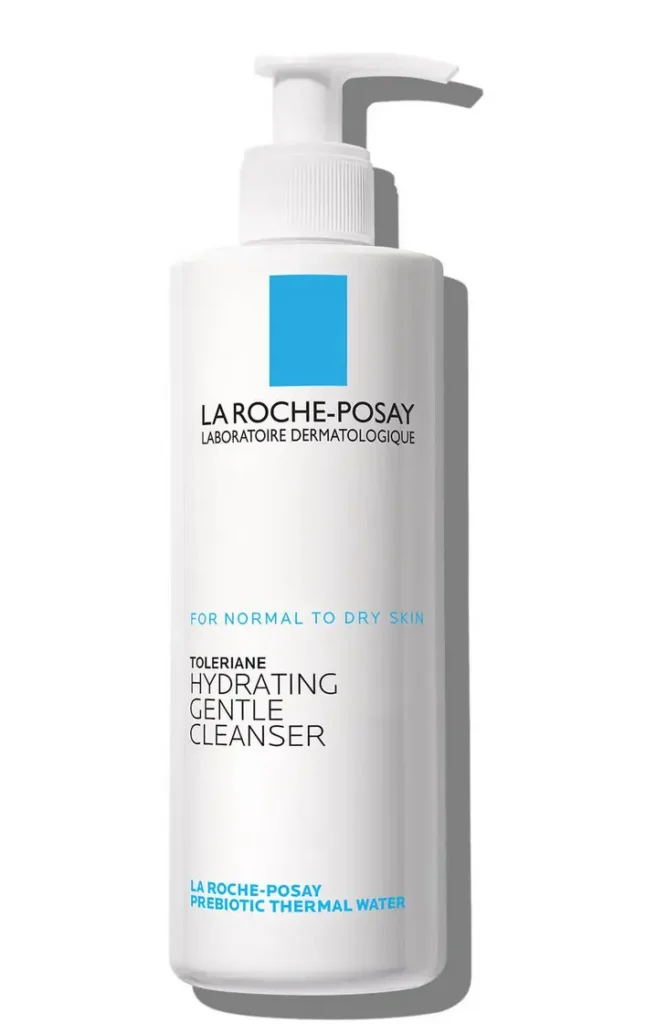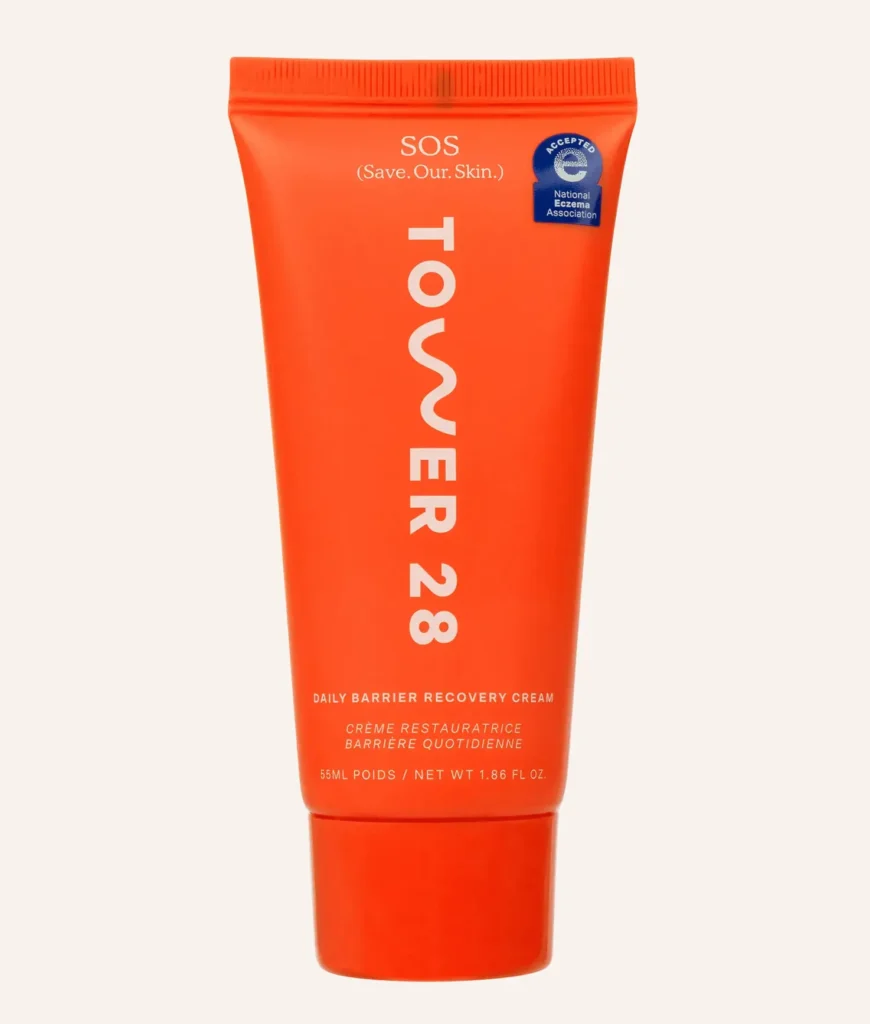
Flaky skin on your face can feel like an endless cycle, one day it looks smooth and calm, and the next, you’re dealing with dry, peeling patches again. No matter what you do, the flaking always seems to return, especially around the nose.
Flaky skin isn’t just about cold weather or dryness, but your skin’s way of signalling that something deeper is off.
Although it’s very tempting (and satisfying) to scrub off dry skin because it’ll fall anyway, there’s actually a good reason for it to be flaky.
To understand what’s really happening beneath the surface is the key to stopping it for good. Once you learn how your skin barrier and moisture balance work together, you can restore hydration and prevent future flaking.
Why Does The Skin Flake?
Flaky skin appears as dry, peeling patches that can make your skin look dull and feel uncomfortable. It becomes more pronounced with age as sebum production drops significantly in the 40s and beyond. According to the American Academy of Dermatology, by the age of 60, nearly everyone has dry skin.
That means moisturising isn’t a choice but a necessity, especially after a certain age.
Flaking occurs when the skin cells do not sit in their usual layers because the skin barrier is impaired. This means that your skin is losing moisture through the lipids, located between the corneocytes.
Corneocytes are dead skin cells that form the stratum corneum (the top layer of the skin).
The stratum corneum is made of:
- Corneocytes: flatten dead skin cells that provide the structure of the stratum corneum.
- Lipid Matrix: composed of ceramides, fatty acids, and cholesterol that fill the space between the corneocytes.
These lipids are hydrophobic and form a watertight seal that slows down the water evaporation, keeping your skin moisturised.
Both corneocytes and the lipid matrix in the stratum corneum are primarily responsible for controlling TEWL.
What is TEWL (Transepidermal Water Loss)?

TEWL is a crucial indicator of healthy skin. It represents the process in which the water evaporates from the body through the skin.
When TEWL is high, you’ll notice certain changes in your skin:
- Dryness and dehydration: these are the most common signs. When your skin loses water faster than it can replenish, you’ll start to notice flaky and scaly patches.
- Increased sensitivity: a damaged skin barrier can no longer effectively shield you from external factors. When the skin loses its ability to protect itself, it will react to external factors (bacteria, irritants and allergens) by becoming red, inflamed, itchy and more reactive, even to products you used before without issues.
- Oilier skin: in some cases, the skin’s sebaceous glands will try to compensate for the lack of moisture by producing more oil. The skin uses this defence mechanism because the sebum (oil) is a lipid-rich substance that is also occlusive. And if you remember what we said about the lipid matrix, you’ll understand why the skin would produce a substance with occlusive properties.
What Causes High TEWL?
High TEWL is caused by a dysfunctional skin barrier.
The skin barrier is affected by a variety of factors, with the most common being:
- Environment: the environment poses a constant change to the skin. Indoor air conditioning and heat exposure can disrupt the skin’s lipid matrix and increase TEWL. Heat can temporarily alter the organisation of lipid bilayers in the stratum corneum, reducing their effectiveness at preventing water loss. Conversely, cold weather can cause the skin to become rigid and more prone to microscopic cracks that allow moisture to escape. Temperatures are not the only factors that accelerate the evaporation process; wind, pollution, and UV radiation also play a role.
- Harsh ingredients and over-exfoliation: the most common yet overlooked causes that compromise the skin barrier is over-cleansing (We have a great article on over-exfoliation titled: 9 Telltale Signs You’re Over-Exfoliating Your Skin). Your skin naturally produces a protective film that contains sebum, sweat, and other components, creating a slightly acidic environment (around 5.5 pH) to inhibit harmful bacteria. This is called the acid mantle. When we cleanse excessively or use cleansers that have powerful degreasing agents to remove oil and dirt, the protective acid mantle is repeatedly stripped away faster than the skin can regenerate.
- Overuse of actives: everybody loves active ingredients because they work. But for actives to work for your skin and not against it, they need to be introduced slowly and not overused. Retinoids, AHAs and BHAs for instance, can thin the stratum corneum, increasing TEWL.
- Skin conditions: certain skin conditions fundamentally alter the skin’s ability to maintain proper barrier function. A common cause of flaky skin is Seborrheic Dermatitis. Other examples are eczema and atopic dermatitis. These conditions affect the production of filaggrin, a protein essential for maintaining the skin’s barrier function. Without adequate filaggrin, the skin barrier becomes “leaky”, allowing allergens, pathogens and irritants to penetrate more easily into the deeper layer of the skin. This persistent water loss leads to dry, irritated skin.
Avoiding habits that damage your skin barrier is just the first step towards helping it. To repair a damaged skin barrier, you’ll need to include certain skin care ingredients in your routine.
How to Support TEWL and Repair the Skin Barrier?

For the skin to look normal, the water content in the stratum corneum must be higher than 10%. When the water level drops below 10%, we experience any of the changes mentioned before.
The good news is that a damaged skin barrier can be improved with topical skincare products, with daily moisturising being the most essential step in preventing dry skin.
The key category ingredients that help support TEWL are:
- Occlusives: the most effective ingredient proven to work is petrolatum. This time-tested ingredient works based on the simple principle of blocking water loss. It’s so effective that it blocks 99% of water loss from the skin surface, and the good part is that it does not impair the barrier function. Mineral oil, which is petrolatum-based, is also effective at forming a tight barrier on the skin surface and is less viscous than petrolatum.
- Wax-based occlusives: waxes like beeswax are commonly used in formulations as thickeners and aid in emulsification in creams.
- Silicone-based occlusives: silicones like Dimethicone are used in many skincare products because they have occlusive properties. Though not as effective as petrolatum (reducing TEWL by 20-30% compared to petrolatum’s 99%), it allows sweat to evaporate while stopping irritants from penetrating the skin.
- Oils and butters: A good example of a butter with high occlusive ability is Shea butter. Shea butter (also an emollient) is a rich, fatty butter that is excellent for softening and conditioning the skin. Another ingredient that is found in many occlusive formulas is Castor oil. This oil is very thick, viscous and has strong occlusive properties.
- Humectants: most moisturisers contain them as they are particularly beneficial for dehydrated and oilier skin. They work by attracting and binding water to the outer layer of the skin. The more popular humectants are Hyaluronic acid, Sodium PCA, Urea, and Glycerin, among others.
- Emollients: another key category of moisturising ingredients that, unlike humectants that attract water, emollients soften and smooth the skin’s surface, repairing the skin barrier. Emollients provide the skin with fatty acids, ceramides, and other lipids it needs to rebuild its barrier. Basically, emollients provide key ingredients for the lipid matrix within to repair itself, reducing the TEWL. Emollients are typically found in thicker products like creams and lotions, with the most known ingredients being Ceramides, Squalane, Linoleic acid and more.
Before we get into topical care, it’s important to remember that healthy skin begins within. Support your barrier with:
- Omega-3s: salmon, chia seeds, flaxseed
- Antioxidants: berries, green tea, leafy greens
- Vitamins A, C, E, and D for renewal and resilience
- Adequate water intake (1.5–2 L/day)
What to Try
For topical care, moisturisers are what you need the most (fragrance-free moisturisers are even better). Most of them will do a good job, and picking one is a matter of preference rather than function. Below you’ll find a cleanser, moisturising serum and moisturising cream:
Top Gentle Cleanser Choice
La Roche-Posay Toleriane Hydrating Gentle Facial Cleanser
Why it works: Contains ceramides, Glycerin and niacinamide to support barrier function
Best for: Sensitive, flaky skin that reacts to traditional cleansers
Application: Use with lukewarm water, pat dry
Pros: Removes makeup without stripping
Cons: Higher price point than drugstore options

Budget-Friendly Option

The Ordinary Amino Acids + B5 Serum
Why it works: Contains amino acids that mimic the skin’s natural moisturising factor
Best for: Dehydrated and Dry skin
Application: Apply to damp skin, follow with moisturiser
Pros: Lightweight, affordable, fragrance-free
Cons: May need additional moisturiser in dry climates
Top Light Moisturiser
TOWER 28 SOS Daily Barrier Recovery Cream
Why it works: Approved by the National Eczema Association, contains ceramides and 4 types of hyaluronic acid
Best for: Weak skin barriers, sensitive skin
Application: Apply morning and night, can layer under sunscreen
Pros: Clinically tested for sensitive conditions, fragrance-free
Cons: May feel heavy/thick for some users

FAQ
Q: How long does it take for flaky skin to improve?
A: With consistent care, you should see improvement within 1-2 weeks. Full recovery may take 4–6 weeks of consistent barrier-supporting care.
Q: Is flaky skin contagious?
A: No, flaky skin itself isn’t contagious. However, if a fungal condition like seborrheic dermatitis causes it, the organism itself could potentially spread.
Q: Why does my nose get flaky even though I moisturise daily?
A: You may be using a formula that’s too light or missing occlusive ingredients. Other causes that can also contribute are environmental factors and underlying conditions requiring medical treatment.
Q: Should I exfoliate flaky skin?
A: Only gently and occasionally (1-2 times per week), avoid harsh scrubbing. Over-exfoliation can worsen the problem by further damaging your skin barrier.
Q: Is flaky skin the same as dry skin?
A: Not always. Dryness is a condition while flakiness is a symptom that signals barrier dysfunction and moisture loss. You can have dry skin and not flake, however, if your skin flakes, it’s almost certainly caused by a lack of moisture.